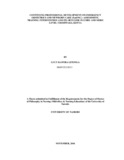| dc.contributor.author | Gichuki, Hillary K | |
| dc.date.accessioned | 2017-01-10T09:10:44Z | |
| dc.date.available | 2017-01-10T09:10:44Z | |
| dc.date.issued | 2016 | |
| dc.identifier.uri | http://hdl.handle.net/11295/100151 | |
| dc.description.abstract | Background: Diabetic foot ulcers are a major complication of diabetes mellitus. These ulcers are prone to bacterial infection and form a major cause of admission into healthcare institutions among patients with diabetes. Determination of local bacterial sensitivity patterns to antimicrobials is important in providing a guide for agent selection for prompt management of the diabetic foot infections.
Objective: The main objective of this study was to determine the prevalence and bacterial sensitivity patterns of antimicrobials in the management of adult diabetic foot infections at Kenyatta National Hospital.
Methodology: A cross sectional design was used to recruit 75 diabetic adult patients with diabetic foot ulcers attending KNH. Convenient sampling was employed in recruiting participants for five months, from April to August 2016. The study was conducted in all medical and surgical wards as well as the diabetes outpatient clinic. Participants` socio-demographic and clinical data were collected by predesigned questionnaire through face to face interviews. Wound swabs from the foot ulcers were collected using sterile swabs and antimicrobial sensitivity patterns conducted in the University of Nairobi microbiology laboratory. Data obtained were analyzed using the statistical package for social sciences software version 20. Statistical significance was set at 95% confidence level and p values ≤0.05 were considered significant.
Results: The study revealed diabetes foot ulcers predominate in diabetic patients aged ≥50 years (70.7%) with a mean age of 55.4 years (± 12.7). Diabetic foot ulcers had a median duration of 2 months (IQR 1.0-4.0 months). Almost 70% of the patients had mono-bacterial wound infection while 9.3% were culture negative. A total of 85 bacterial isolates were identified and the ratio of gram negative to positive infections being approximately 1:1. The most prevalent organisms were Staphylococcus aureus (37.3%) followed by Proteus (21.3%) and Klebsiella species (14.7%). Among the Staphylococcus aureus, 39.3% were methicillin resistant. The most frequently prescribed antimicrobial for diabetic foot infections was flucloxacillin (34.7%) followed by metronidazole
xiv
(33.3%) and ceftriaxone (22.7%). All the gram positive bacteria were sensitive to imipenem and ciprofloxacin whereas most of the gram negative organisms were sensitive to imipenem and piperacillin-tazobactam. Sensitivities to amoxicillin-clavulanate, meropenem, clindamycin, ceftriaxone, piperacillin-tazobactam and ciprofloxacin to different isolates varied. Klebsiella species were sensitive to imipenem, piperacillin-tazobactam, amikacin and meropenem but resistant to ceftriaxone, clindamycin and cefuroxime. Proteus species were sensitive to piperacillin-tazobactam, ciprofloxacin, imipenem, ceftriaxone and meropenem but resistant to clindamycin, cefuroxime and ceftazidime. All the isolates of P.aeruginosa were resistant to clindamycin and cefuroxime but showed high sensitivity towards piperacillin-tazobactam and imipenem.
Conclusion: In Kenyatta National Hospital, gram negative and positive bacteria infect diabetic foot infections in almost equal proportions but both isolates are highly sensitive to imipenem. This suggests that empiric treatment of the foot ulcers may be initiated with imipenem prior to culture and sensitivity results, which are necessary because of the unpredictable nature and antibacterial sensitivity patterns of organisms causing the infection. Large studies should, however, be conducted to determine the reasons behind the growing resistance to amoxicillin-clavulanate which is commonly used in the hospital. | en_US |
| dc.language.iso | en | en_US |
| dc.publisher | University of Nairobi | en_US |
| dc.rights | Attribution-NonCommercial-NoDerivs 3.0 United States | * |
| dc.rights.uri | http://creativecommons.org/licenses/by-nc-nd/3.0/us/ | * |
| dc.subject | Patterns of Antimicrobial Agents | en_US |
| dc.title | Prevalence and Bacterial Sensitivity Patterns of Antimicrobial Agents for Diabetic Foot Infections at Kenyatta National Hospital | en_US |
| dc.type | Thesis | en_US |
| dc.description.department | a
Department of Psychiatry, University of Nairobi, ; bDepartment of Mental Health, School of Medicine,
Moi University, Eldoret, Kenya | |


